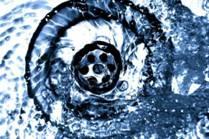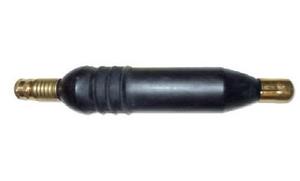Is your clogged drain slowing you down?
My bathroom sink has been draining very slowly and it has almost stopped, what is the best way to get the pipe cleared?
Cindy S. - Whitmore Lake Hi, Cindy, I remember plunging my bathroom sink when my 5-year-old daughter asked to help me. Being a new father, I thought I’d show her a thing or two about plumbing. I filled the sink with cold water, approximately 3 inches high, brought out my handy-dandy plunger and started plunging away ... and away ... and away. Although, I could hear the air flowing each time that I’d plunge, the clog did not give way and the water remained at a standstill. That is until my daughter asked me why there was a hole in the top front end of the sink.
After I explained to her that the purpose of the hole in the sink was to prevent the sink from overflowing, I then covered the hole with a wet rag and continued to plunge. The hair and soap scum in the trap began to loosen and the drain began to clear.
If plunging is unsuccessful, there are a few alternatives below that can help.
The pipe attached to your sink drain is called a trap. It normally is shaped like a letter “P” and in some cases an “S” and sometimes will be referred to as a “P-Trap” or “S-Trap”. The trap can be made of plastic or metal and both work very well. To clear the trap, first clear out all of the items beneath the sink and place a small bucket up under the pipe. This will catch any water and debris once the trap is apart. If it is a plastic trap remove the plastic jam nuts with your hand and gently slide the trap into the bucket. After the trap is clean re-install it the same way and make sure the jam nuts are tight to prevent leaking. If it is a metal trap you will need some adjustable pliers to remove the jam nuts but follow the same procedure.

Photo by m4r00n3d
Another tool commonly known as a “drain cleaning bladder”, can be inserted into your sink drain, and connects to a garden hose that is used to fill a bladder. The bladders seal the pipe, fill up with water, then pressure blasts the clog and debris free. Costs range from $12to $20, these tools can be less messy than the typical drain snake, however caution must be used on plastic and unsecured pipes because the pressure build up can literally blow the trap loose under the sink.
Chemical drain cleaners are commonly used among homeowners with a slow and clogged drain. These products are highly controversial due to the dangers of the powerful chemicals involved, and are discouraged by most plumbers because of the damage that it can do to the drain system. Used incorrectly, the chemicals can also cause skin burn and eye damage. BE SURE to follow the directions carefully when using these products. I have cleared a few drains using maximum-strength cleaners from the grocery store. Keep in mind, there is some plastic piping that can be damaged by certain products and the chemicals can be damaging to a septic system.

Photo from amazon.com
If further problems exist, it is possible the clog is further down the line of the pipe and you’ll need to call a licensed plumber to remove it.
As with most home repairs, preventive maintenance can save a lot of time and repair bills. There are products on the market that can help keep the “biofilm” to a minimum when used regularly. The vinegar and baking soda is a good monthly method as well. Remember, it is easier to clear a slow drain rather than a plugged one.
Paul is a State of Michigan Licensed Builder. Paul serves as President and founding member of Nationally franchised HandyPro Handyman Service, servicing Washtenaw, Wayne and Oakland Counties. Listen to Paul every Saturday at 11 a.m. on “It’s Your Home, Let’s Talk About It” WAAM Talk 1600AM. E-mail questions or comments to kpaul@handypro.com


Comments
Keith A. Paul
Mon, Jun 28, 2010 : 7:05 a.m.
I visited the website, it appears to be an interesting tool. I just ordered it. Thanks for the tip. kp
Technojunkie
Sat, Jun 26, 2010 : 6:52 p.m.
I've had good luck with a tool called Flexisnake for cleaning those annoying modern drains that won't allow a traditional drain snake to be used. That, followed up with vinegar and baking soda as described, works well for unclogging bathroom drains.